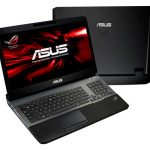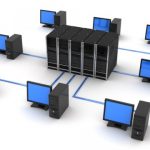Overhauling a home network, Part 2 -- back to FreeNAS afterall

Let us get a bit geeky. This was not my original intention, but it is how things turned out in the end. First, I believe I misspoke twice in part one of this series -- one time was unintentional, the other was apparently my wishful thinking. The first was when I called my recent used server purchase a Dell Optiplex. It is actually a Dell Poweredge. The second involved my new operating system and I'll get to that in a second.
To begin with, the server was running Windows Server 2003 and the small business I purchased it from had failed to wipe the data, but did leave it password protected -- something a tool like Ophcrack may have been able to breach, though I had no desire to try. The server also contained a CD-ROM drive which I needed to replace with a DVD drive in order to install Windows Server 2012 Essentials. Fortunately I had one laying around -- yes, I know that is not normal. You should see our storage room. There are boxes of computer parts and a stack of old towers filling a corner. At least this time the "it will be useful someday" statement worked out for me.
However, the 32-bit server architecture did not support 2012, meaning I moved on to Home Server -- that required 512 MB of RAM, and the server, woefully older than I had thought, only had 256 -- an easy upgrade, but expenses and wife-acceptance-factor for this project were mounting up.
Overhauling a home network, Part 1 -- Making decisions

Over the years the little network within my humble abode has grown. It started as a way to connect a laptop and a desktop, but has since become a conglomeration of multiple devices -- a desktop, three laptops, an HTPC, a home server and even three smartphones. Not to mention that the Blu-ray player, DirecTV DVR and Netgear NeoTV are networked. It all comes together in a combination of ethernet and WiFi connections that are controlled through a router in the home office on the third floor of our old restored Victorian, an extender which resides in the entertainment cabinet in the living room -- sorry, "parlor" since it is a Victorian -- on the first floor and a network switch in the basement.
Parts are getting old however -- in the past year I had to buy a new router and replace my daughter's laptop. Recently, more things have become unreliable. My home server, which ran FreeNAS died recently. It was housed in an old tower PC that had once been our desktop. Our HTPC has grown old, despite having been upgraded with new video and audio cards and additional RAM. The Netgear NeoTV is not as reliable as it once was.
NetTraffic lets you monitor your network activity in real time

Launch your PC and very soon there will be a host of processes making use of your internet connection. Your antivirus program might download new definitions; other programs will check for updates; your email client may scan for new messages, and of course there’s also your browser, download manager and anything else you’ve directly launched for some specific task.
If you have unlimited internet access and a speedy broadband connection, none of this will matter very much. But if you have limited bandwidth, a slow connection, or you’d just like to track your system’s network use, then installing NetTraffic could be a great way to monitor exactly what’s happening.
Cisco buys 'Networking-as-a-Service' pioneer Meraki for mid-market growth

Networking leader Cisco announced on Sunday evening its intent to acquire San Francisco-based cloud networking company Meraki Inc. Cisco will pay approximately $1.2 billion in cash and incentives to acquire Meraki, and the deal is expected to close in the second quarter of 2013.
Meraki's portfolio of technologies includes a broad range of networking solutions, including mesh Wi-Fi, switching, security, and cloud-based mobile device management which currently target midmarket companies. In other words, companies with annual revenues between $100 million and $1 billion. In the United States, this market segment is made up of approximately 200,000 companies, and it is looked at as a growth market for tech infrastructure providers.
PortScan sniffs out network activity

If you ever help others out with their PC problems then you’ll know that network issues can be particularly troublesome. And just getting started, finding out exactly what might be connected to the system you’re looking at, can take quite some time.
Having a network scanner to hand can greatly simplify the troubleshooting process, though, by carrying out most of the low-level inventory checks on its own. And PortScan is a great example of this tool type.
It's time to stop bufferbloat

This is my promised update on bufferbloat, the problem I write about occasionally involving networks and applications that try to improve the flow of streaming data, especially video data, over the Internet but actually do the opposite, defeating TCP/IP’s own flow control code that would do the job much better if only it were allowed to. I first mentioned bufferbloat in January 2011 and it is still with us but the prognosis is improving, though it will probably take years to be fully resolved.
If you read my last column on LagBuster, you know it’s a hardware-based workaround for some aspects of bufferbloat aimed especially at gamers. LagBuster is a coping strategy for one type of bufferbloat that afflicts a population of people who aren’t willing to wait for a systemic cure. LagBuster works for gamers and might be a workaround for other kinds of low-latency data, but that’s still to be determined.
Need to check your router settings? Try rCon

Years of PC-related experience -- software development, support and more -- have made me the go-to guy whenever friends or family have computer problems, and for the most part that’s just fine: I enjoy the technical challenge.
There are some issues which seem to crop up over and over again, though. And figuring out exactly how to access the settings page on a router is one of the most common.
Incumbent mentality drives the wireless communications industry to the crisis point

It's been almost three years since the Federal Communications Commission began warning us that we are consuming more wireless bandwidth than the airwaves can support, and in those three years, relatively little has changed to fix the situation. Lightsquared attempted to cleverly utilize satellite-band spectrum to build a ground-based 4G network, but those attempts were squashed by the GPS lobby, and could take another five years to come back.
The FCC is still on its quest to free up a total of 300 MHz of wireless spectrum by 2015 for mobile broadband data services, but time is rapidly running out on that promise. Last Wednesday, FCC Chairman Julius Genachowski announced the commission would be updating its wireless spectrum policies by the end of the year to help free up about 100MHz worth of spectrum in the 3.5 GHz band.
Google's Kansas City ultra-fast fiber network set to debut

Residents of the Kansas City metropolitan area are close to having access to super-fast Internet as Google unveiled its fiber-to-the-home service on Thursday. For as little as $70 per month, Google will provide 1 Gigabit Internet service to customers in both Kansas City, Mo. and Kansas City, Kan.
The service will also include a television component for an additional $50 per month. Deployment depends on the number of consumers that pre-register in a specific area: Google will only complete runs of fiber-optic cable to where the demand is highest.
VMware acquires virtual networking software company Nicira for $1.05 billion

On the same day as reporting strong second-quarter results, virtualization software developer VMware said Monday that it has entered into an agreement to purchase network software Nicira for $1.05 billion. The company's software is used to manage network deployments and create virtualized network infrastructure. VMware expects the deal to close in the second half of the year.
"The acquisition of Nicira adds to our portfolio of networking assets and positions VMware to be the industry leader in software-defined networking", VMware CEO Paul Maritz says. Others called it a major move which positions VMware well in the fast-growing cloud computing sector.
Cisco debuts networking products for the cloud

Cisco knows that the cloud is worthless without networking, so its Cloud Connected Solution announced on Wednesday shouldn't surprise anyone. The company debuted both new cloud-enabled software for its ASR and ISR routers as well as a virtualized router aimed at extending virtual private networks to the cloud.
This new router software will be found on the ISR G2 platform, and a new Aggregation Services Router (ASR) platform based router, the ASR 1002-X was introduced. Cisco announced new Unified Computing System (UCS) E-Series Server Modules on the ISR G2, which is also on the way.
Asus introduces the first notebook with next-gen Wi-Fi

One of Broadcom's goals for 2012 is to bring to market new hardware that supports the fifth-generation of Wi-Fi networking standards, 802.11ac. At CES 2012, Broadcom debuted its first 802.11ac chips, then rolled out more designs in the following months so device manufacturers could take advantage of the faster throughput the new standard allowed.
Asus, D-Link, Huawei, and LG all have announced plans to support 802.11ac with consumer hardware, and this week, Asus and Broadcom unveiled the first consumer-facing notebook computer to feature full 802.11ac compliance, the Asus ROG G75VW gaming notebook.
Take control of remote PCs with PAExec

Managing a Windows network can be a full-time job; there’s always one problem or another demanding your attention. You could run around from computer to computer, addressing issues as they crop up. But you may be able to save some time and trouble by using PAExec, which can launch programs on remote PCs, and (if they’re console applications) redirect their output back to your own system.
Enter a command like PAExec \\{SystemName} -s cmd.exe, for instance, and PAExec will connect to the specified system and open a command prompt there. You’ll then be able to enter regular Windows commands to find out more about the issue, they’ll be executed on the SystemName computer, and you’ll see the results on your own PC.
The world's average download speed: 580KBps [data]

Pando Networks, the content delivery network company that opened up its traffic data to show that Idaho has the United States' slowest Internet connections has released a "State of the World" tally of Internet speeds across most of the globe, revealing how 224 countries stack up in terms of network speeds.
Based on 27 million downloads by 20 million different computers between January and June 2011, Pando has come up with its own official average world download speed: 580KBps.
Recent Headlines
Most Commented Stories
© 1998-2025 BetaNews, Inc. All Rights Reserved. Privacy Policy - Cookie Policy.